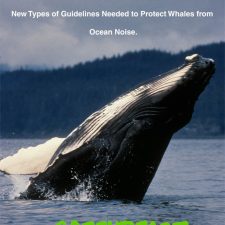An Evaluation of the Impacts of Specific Anthropogenic

It is well established that certain anthropogenic noises have a severe effect on whales. Many sounds that humans introduce into the sea today are without precedent in the evolutionary history of marine mammals and other ocean life. Seismic testing associated with oil and gas exploration, military SONAR, and other industrial sources of ocean noise have injured or killed dolphins and whales in many instances. Additionally, behavioral impacts can also be severe, with animals interrupting feeding, nursing, or reproductive activity to flee from disruptive or painful sounds. There is also evidence that whales may be subject to “masking,” where some types of noises interfere with their ability to communicate with each other. As the military and industrial producers of these sounds are required by law in some countries to prevent impacts to marine mammals, there has been considerable debate and litigation in response to this continuing problem. Various mitigation schemes have been proposed, but they have not proven effective in eliminating harm to whales. Despite a wealth of information demonstrating the need to address multiple characteristics of sound, such as form, frequency, and periodicity, mitigation levels have thus far focused only on signal amplitude, or volume. Many of the studies have also been focused on physiological thresholds such as “threshold shift” using sinusoidal-derived signals which may not accurately reflect the types of anthropogenic noises to which whales are exposed.1,2 Mitigation levels based on these thresholds and signal types are often higher than known behavioral thresholds. It is clear from the literature that marine mammals avoid certain types of signals at significantly lower amplitudes than naturally occurring signals or other types, frequencies and forms of anthropogenic signals.
This paper presents data on signal-specific biological responses of cetaceans and calls for incorporation of signal types as well as decibel levels when establishing noise exposure criteria for whales. Given the existing evidence that cetaceans are adversely impacted by a range of noises far below current mitigation levels, a more precautionary approach is needed.
Michael Stocker



















